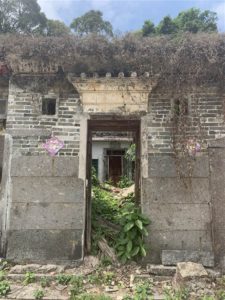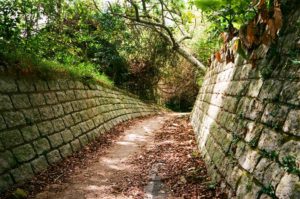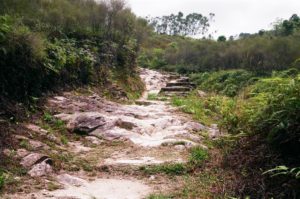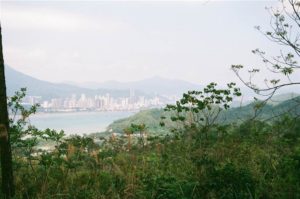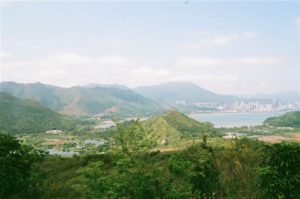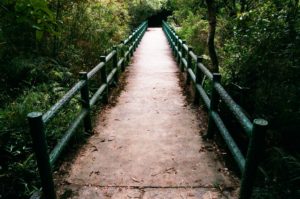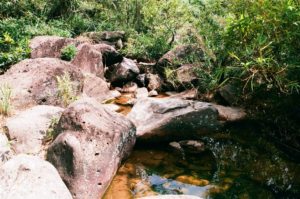Beautiful Sha Tau Kok – The Surprising Gem of Sir Edward Youde Memorial Pavilion

My original intention this day was to visit the potholes of Shek Pan Tam Pool in Nam Chung, Sha Tau Kok. I guess it would not surprise readers that I lost my way again. All thanks to Google GPS, which gives poor directions for hikers on country trails.
Once arriving in Nam Chung, I parked and headed off to Luk Keng. I knew that there was a way to the Shek Pan Tam Pool (also known as Ka Lung Tam) from Luk Keng. I had a pleasant stroll in the Luk Keng Village. There were some interesting sights of ruins within the village. It seemed to me that a number of villagers have deserted their houses, but enough good houses stood to keep it a viable community, unlike many other villages in the area, where whole villages deserted their homes.
At the end of Luk Keng Village I came upon the hiking trail. It was a very nice set of stone-paved steps. Generous shades blessed this first part of the trail. But then I saw the sign to the Edward Youde Memorial Pavilion, and I realized that I must have missed the opening to the Shek Tam Pool. So be it, I thought, the Edward Youde Memorial Pavilion it was.
The stairs took me about an hour. I felt a great sense of accomplishment when I saw signs pointing to the Pavilion. Even on my way, I saw beautiful views northward, of the high rises of Shenzhen.
Sir Edward Youde was the only Governor in Colonial Hong Kong that died in office. He began his service in Hong Kong in 1982, in a time of uncertainty. It was during his administration that the Sino-British Joint Declaration was signed in 1984. Passed away in Beijing in 1986, Sir Edward Youde was succeeded by Lord David Wilson. The Northern District District Council established this beautiful twin pavilion to commemorate Sir Edward Youde, who had taken the interests of Northern New Territories to heart when he was in office. Lady Youde initiated the Pavilion in 1988.

The view at the Pavilion was breathtaking. It was an aerial panorama of the Nam Chung and Luk Keng areas. There were some beautiful fish bonds, surrounded by the ranges on the horizon. Every road leads to Rome, I thought, and despite not finding the Shek Pan Tam, I found another treasure. I had no time to lose however, as I still hoped that I might find the pool after all. It was certainly in the vicinity and so I hurried off.
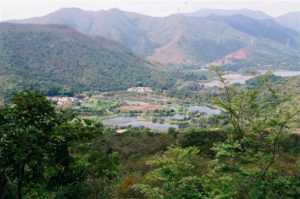
I followed signs for Nam Chung. On my way I passed by the Ping Ka Stream, with origin at Ping Fung Shan (Ping Fung Mountain). When this section of the Wilson Trail (Section 10) was built in 1995, the Kiu Shan Bridge provided the throughway over the stream, which usually flooded during rainy season and blocked passage. The rural leaders of the area named this bridge after Kiu Shan School, which was a school for the four neighboring villages in this area.
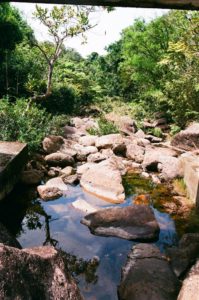
In early afternoon the sun was right above me. I was on my way back to Nam Chung. It was a steep descent for about 20 minutes. I passed by the helipad, the Pat Sin Leng Country Park Luk Keng Management Center, then I reached the starting point of Wilson Trail Section 10, and the Nam Chung Country Trail. Once on Nam Chung’s main road, there was almost no shade.
The views on Nam Chung’s main road was surprisingly good as well. There were many fish ponds. I figured that this was the ground view of the ponds that I saw up at the Sir Edward Youde Memorial Pavilion. The villagers led a quiet and peaceful life here, it seemed to me, tucked away in the rural pockets within the embrace of mountain ranges.
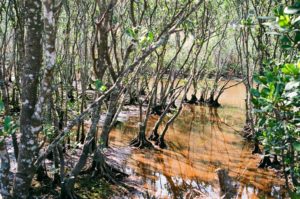

As I came upon the main highway, I realized that this was right where I parked my car. I could have come this way instead of walking 20 minutes to Luk Keng to start my trail. But I was glad, because the hike up the steep incline on Wilson Trail Section 10 would have been way worse than the stone-paved steps at Luk Keng.
And my next destination has to be Shek Pan Tam. I promised myself that nothing is impossible with better research.


